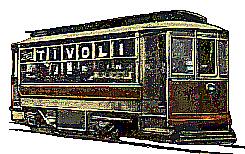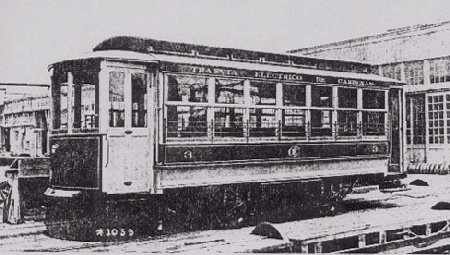


Between 1914 and 1929, Cárdenas had an electric street railway system called the "Tranvía Eléctrico de Cárdenas." It connected and served each of the city's important neighborhoods or "barrios." The trams were powered by large batteries and did not require the use of unsightly overhead wiring nor the trolley poles that connect regular electric trams to the overhead wires.
 |
one of the Tranvía's regular stops. This car apparently doubled as a rolling billboard for "Maltina TÍVOLI Vitaminada" made by "Cervecería La Tropical". |
The cars are said to have offered comfortable seating as well as a very smooth ride, due to their sophisticated suspension system. They were built by the St. Louis Car Company in St. Louis, Missouri, U.S.A. It is suspected that the first three cars used by the Tranvía de Cárdenas were borrowed or bought from either Cienfuegos or Havana, because the first order on record for the Cárdenas company was delivered by the St.L.C.C. in 1915. Battery-powered trams were uniquely suited to Cárdenas, due to the city's perfectly flat terrain, and the cars never experienced any significant operating difficulties in Cárdenas, although this was not always true on hilly terrain like that of Havana.
The "Tranvía Eléctrico de Cárdenas, S.A." company was formed in 1913, and all work on the mechanical and carpentry shops, as well as the rail lines, was completed on schedule for its Cuban Independence Day opening on May 20, 1914. The facilities, including the electrical plant used to charge the cars' batteries, were located on Carrillo Avenue, between Calzada and Velazquez streets.
 |
Among the technicians who took part in the construction of the electrical plant, were Eugenio A. Hernandez Masdeu, an electrical engineer by profession, and Genaro Sabater, an expert in the design and construction of electric batteries.
A 1918 survey conducted by the U.S. government shows that the Tranvía Eléctrico de Cárdenas had 12 cars and 7 miles of route at the time. Usually, only four cars would circulate about the city at the same time, while four more were in line waiting to be put in service after having their batteries recharged or going through other routine maintennance. The remaining four were kept in reserve as part of normal operating procedure, or may have been undergoing more extensive maintennance or repairs.
The lines were laid out around the city in such a way as to serve the greatest number possible of the city's population of the time. Switches were placed anywhere the lines intersected so that the cars could run different routes, as well take the shortest route possible back to the shop when the batteries would start to run out of power.
 |
Ten 5-cent fares entitled a rider to the eleventh fare for free. |
In 1918 the company's officers included many prominent members of the Cárdenas business community, including José Maria Verdeja, Ernesto & W. R. Castro, Frank & Jorge Larrieu, Leandro Ruiz, Ed. Elgarresta, Luis E. García & M. G. Sabater.
 |
The Cárdenas Tramway cars were built by the St Louis Car Company, St. Louis, MO. |
By 1929, the Tranvía had begun to experience a lot of competition from the bus service initiated in the city by Mr. Picón, who offered service not only in the developed areas of the city, but also to the newer growth areas not reached by the less-flexible rail system. In his 1928 "Historia de Cárdenas," Cuban historian and Cárdenas native, Herminio Portell-Vilá points out that the enterprise was never properly funded and that this problem became more acute in its later years. The death knell of the Tranvía Eléctrico de Cárdenas was the stock market crash of 1929 and the ensuing great depression, which made it impossible to obtain spare parts for the system. The system ceased operations in mid-1929 and the cars were eventually sold to an unknown Latin American country.
There remains very little physical evidence of the tranvía system ever having existed in Cárdenas, although 40 years ago one could still see some of tracks along Vives Street. Perhaps some of those tracks are still there? Will someone please tell us!
|
Mr. Allen Morrison maintains a website dedicated to Latin American electric rail transportation.
as well as http://members.aol.com/almo1435/eti.html |
